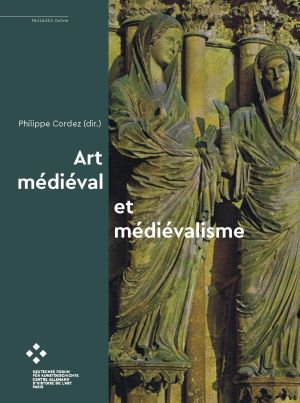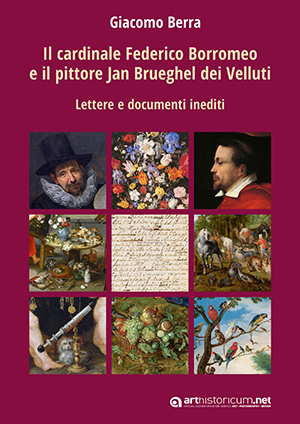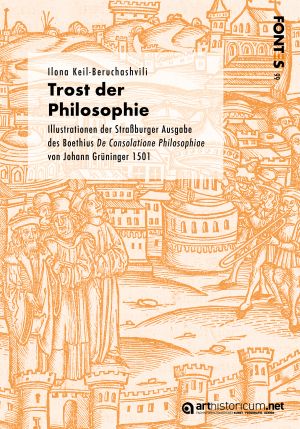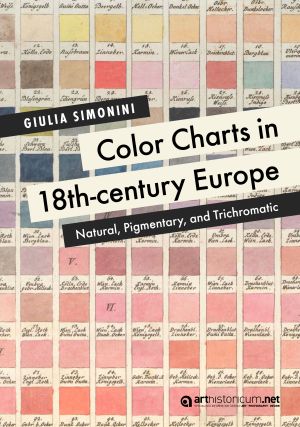Books

Art médiéval et médiévalisme
The ‘Middle Ages’ is a recent and shifting creation, at once a stratified historiographical elaboration and an appreciation of historical objects in the present. What we know and imagine shapes our perception. Studying the medieval arts therefore requires us to study medievalisms, and vice versa.
This volume, the result of work carried out in 2015/2016 at the German Centre for Art History in Paris, brings together fifteen studies on medieval artefacts and their subsequent history, up to the present day. They are accompanied by a review of German-language studies of medieval art in France since 1933.

VER – WANDLUNG – EN
The exploration of changes and transformations in art and art history is a rich and multifaceted endeavor. Following the 100. Kunsthistorischer Studierendenkongress (100th Art History Students’ Conference) themed “VerWandlungEn” (Transformations) this edited volume documents academic research focused on these dynamic processes. It highlights metamorphoses across various artistic subjects, media, structures, and institutions, addressing the inherent changeability and development within the field. In addition to outlining specific topics, fundamental questions about the student conference itself will also be addressed.

Vom Fließen der Dinge
The idea that the beginnings of the universe do not lie in the solid, hard, rigid, but also not simply in the opposite, the flowing and streaming, has occupied natural philosophical reflections for thousands of years. To this day, however, a binary-structured view of the world has unfolded in all its power. Impulses can already be identified in the early modern history of ideas and images that undermine the supposedly static, immobile and instead emphasise the changeable, ephemeral and dynamic. Stasis is dynamised and subjected to transformation in many different ways and in just as many different areas. The contributions in this volume present case studies from philosophical, physical, geoscientific, climatological and art scientific perspectives that bring the phenomenon within an interdisciplinary spectrum

Il cardinale Federico Borromeo e il pittore Jan Brueghel dei Velluti
This study presents various unpublished letters whose senders or recipients were the cardinal and archbishop of Milan Federico Borromeo, his nephew Count Giovanni Borromeo, the painter Jan Brueghel (Velvet Brueghel) and his son Jan Brueghel the Younger. Some of these missives allow us, also through a comparison with other documents already known, to almost hear the voice of the cardinal himself talking to his favourite Flemish painter, whom he admired so much. Furthermore, published here for the first time are various payments in favour of Jan Brueghel ordered by Cardinal Borromeo and recorded in the account ledgers of the archiepiscopal Curia of Milan. This work discloses also other letters and several unpublished archive papers which allow us to have more precise information not only on some paintings located in the Pinacoteca Ambrosiana, but also on some institutions linked to the Biblioteca Ambrosiana, such as the Accademia del Disegno and the Collegio dei Dottori. A chapter of this study is also dedicated to the problematic relationship between Cardinal Borromeo and Caravaggio with the analysis of some significant, little-known testimonies relating to the Lombard painter.

Das EU-Format „Kulturhauptstadt Europas“ zwischen lokalen und internationalen Kulturpolitiken
The ‘European Capital of Culture’ is regarded as the European Union's flagship cultural policy initiative. A total of eight German cities applied in a selection process for this title for 2025, which was ultimately awarded to Chemnitz. Cultural and cultural policy events and, for example, public discussions in the cities preceded the submission of the bid books. The article provides an insight into the selection process, the city's application activities and the local urban, cultural and European policy debates. It shows how different interpretations of the EU format intertwine and favour its success.

„Uf falsch papir erhecht“

LIDO-Handbuch für die Erfassung und Publikation von Metadaten zu kulturellen Objekten
Volume 3 of the LIDO Handbook focuses on architecture and other immovable works. In order to aggregate data from different subject-specific information systems on cross-institutional platforms such as the German Digital Library, it is necessary to apply common standards for data content and data structure. This manual is an application profile of the LIDO metadata standard, containing all the data fields relevant for the description of immovable works, e.g. architecture. It explains each data field and provides advice on recording, examples of content and instructions for exporting data in the LIDO XML format. All recommendations are aimed at preparing data from different sources in order to achieve the most comprehensive and accurate search results and to open up paths for further information cross-linking.

Trost der Philosophie

Color Charts in 18th-century Europe
This book examines the phenomenon of color charts that were created, developed, and sometimes published in 18th-century Europe. In this work, for the first time, color order systems, painters’ and dyers’ sample books and the tables of natural historians are all considered as color charts. The book offers a historiographical categorization of the charts into natural, pigmentary, and trichromatic color charts and then scrutinizes and explains what their differences are based on and what factors are responsible for their similarities. For this purpose, this work brings to light, compares, and analyzes numerous primary sources and colorful illustrations.

Das Frontispiz in der Kunstliteratur

The EU's European Capital of Culture format between local and international cultural policies
The ‘European Capital of Culture’ is regarded as the European Union's flagship cultural policy initiative. A total of eight German cities applied in a selection process for this title for 2025, which was ultimately awarded to Chemnitz. Cultural and cultural policy events and, for example, public discussions in the cities preceded the submission of the bid books. The article provides an insight into the selection process, the city's application activities and the local urban, cultural and European policy debates. It shows how different interpretations of the EU format intertwine and favour its success.

Under Shelling: Art Historical Revisions in the Light of the War in Ukraine

Le chevet de l’église romane

Das Altarretabel des Monogrammisten H.L. in St. Michael in Niederrotweil am Kaiserstuhl
The subject of the study is the retable of the high altar in the church of St. Michael in Niederrotweil am Kaiserstuhl, created by the monogramist H.L. It is one of the highlights of wooden sculpture in the Upper Rhine region at the end of the Late Gothic period. Based on the material and technical findings as well as taking into account the long history of research, the original appearance and the changes made later are clarified. A further focus is the detailed analysis of the representations. These are - hitherto unrecognised - to be seen as extremely critical artistic confrontations of H.L. with works by Hans Baldung and Albrecht Dürer. The peculiarities of the artistic design and the question of dating are also discussed.

Dionysos des lumières – Aux sources de la modernité artistique
Folgt!

Le mythe Le Brun,entre attaqueset critiques
folgt

The Paris World Fairs – (Re-)Productions of Art and Fashion
folgt

Matrice et Signum – La Croix dans la Culture Médiévale occidentale Histoire de l'Art et Anthropologie
folgt

Rhythms and Resonances. Sounding Objects in the Middle Ages
folgt

Hello Nature

Anatolian Rugs from Bistritz/Bistriţa
folgt

Beruf, Blick und Bild
Women rarely appear in the traditional history of photography. Their tracks are lost in historical reception, they are virtually 'hidden' or are assigned the status of an exception. Based on biographies, the author traces the development of female photography. The social, educational and technical conditions that women encountered from the end of the 19th century are also examined. The young and liberal professional field of photography enabled well-trained women to work creatively and achieve economic independence. With this study, Nathalie Dimic does pioneering work by depicting the social figure of the female photographer in an interdisciplinary and multidisciplinary way for the first time.

Diving into artworks interpretations through the lenses of semantic data: an application on Panofsky’s iconological studies

Gotthard Jedlicka

Arte flotante. Mobility and Mobilization in the Art of Post-war Argentina
In 1956, the first floating exhibition of Argentinian art circled the globe. This travelling exhibition on a ship also marked the inaugural activity of the newly founded Museum of Modern Art in Buenos Aires. This publication sheds light on Argentina's presence in the global art world of the post-war period and discusses the factors behind the realization of this mobile exhibition format. Based on previously unpublished archive material, it reveals how the ocean served as an exhibition space by those actors who have barely entered the canon of modern art history. Arte flotante thus contributes to global art and exhibition history.

Instant Public Art

Digital 3D reconstruction as a research environment in art and architecture history

Jean-Luc Godard INFRASTRUCTURE(S) GRAND(S) ENSEMBLE(S) DÉ/MONTAGE(S). A study of Opération „Béton“, Deux ou trois choses que je sais d’elle, and Le Livre d‘image
This study of Jean-Luc Godard (1930-2022) combines an interest in the history of the built environment (in french décor) with that of cinematic décors. The interrelations between décor, film characters and, in the case of cinematic installations, beholders are examined in the respective work and through historical contextualisation of the film and construction projects. The three chapters focus on Godard's debut film Opération ‘Béton’ (CH 1955), Deux ou trois choses que je sais d'elle (FR 1967), which marks the transition to his political phase, and his late work Le Livre d'image (CH/FR 2018-), which unfolds as installations in space.

Kunst der Fotografie
As a forum of international exchange, the photographic journal Camera, founded in Lucerne in 1922, played a central role in shaping the afterlife of Pictorialism. Through numerous image and text analyses and an in-depth examination of the magazine as a medium, this study demonstrates how the journal Camera itself, through media-specific means, actively participated in the negotiations on what good artistic photography was. The book sheds light on the dynamic developments of the hitherto little-researched late history of pictorialist photography in the 1920s and 1930s and ultimately challenges the notion of Pictorialism as a rigid antithesis of the ‘modernism’.






